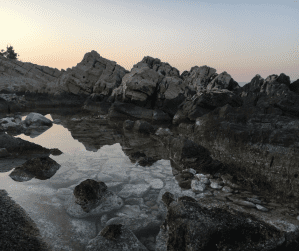Exploring The Adriatic Coast of South East Europe
Often considered among the most beautiful waters to see and swim in, the Adriatic Sea is an integral part of life in South East Europe, specifically in Croatia, Slovenia, Montenegro, Albania, and Italy, whose borders run along the Adriatic coast.
 One of the Adriatic coast’s striking features is the white stone which marks the ever-shifting boundary between land and sea. Near the water, the stone is encrusted with shells and barnacles, colored brown with seaweed and centuries of erosion. Farther from the shore the stone is pale, textured with indentations, and laced with cracks and schisms. Rosemary bushes and pine trees are found close enough to the shore that their branches hang over the water, creating shadowed nooks and clusters of pine needles among the rocks.
One of the Adriatic coast’s striking features is the white stone which marks the ever-shifting boundary between land and sea. Near the water, the stone is encrusted with shells and barnacles, colored brown with seaweed and centuries of erosion. Farther from the shore the stone is pale, textured with indentations, and laced with cracks and schisms. Rosemary bushes and pine trees are found close enough to the shore that their branches hang over the water, creating shadowed nooks and clusters of pine needles among the rocks.
On sunny days, sailboats and ferries dot the horizon, along with smaller fishing boats, especially near villages. Ferries carry the local inhabitants of the islands to and from cities, and during the summer they run every few hours. The sea is also home to over 7000 plant and animal species and is so clear that while swimming one can see the fish, either lurking near the seafloor or else darting synchronously through the waves in schools.
Some jump above the surface, a quick gleam of silver in the sunlight before disappearing underwater again. Squids, crabs, dolphins, and other common marine wildlife are also found in these waters, and there are rarely any large or dangerous creatures, though the occasional lost fin whale or young shark appears while searching for a way back to the Mediterranean.
In recent years, concerns about threats to marine ecosystems in the Adriatic have grown, including worries about overfishing and pollution; these are the same problems plaguing coastal environments all over the world right now. Poor waste management and carelessness from tourists has led to trash floating in the sea and washing up on shores, which in turn affects the wildlife.
Although it is still safe to eat fish from the Adriatic, pollution may change that in the future. Moreover, of the over 450 fish species identified in the Adriatic, about 60 are considered endangered or nearly endangered, according to various red lists on endangered species in the Mediterranean and Adriatic.
Pollution concerns are exacerbated by commercial endeavors, especially cruise ships, which have become a frequent sight in ports. Although they bring tourists and therefore business, the environmental damage to the coast has caused many to question them and look for alternatives, such as more  traditional-style ships which can also carry tourists between Adriatic islands and cities. Split and other large coastal cities have a rich history of flourishing shipyards and capable sailors, and have produced all kinds of vessels. Their older ships have a long history, such as the Polaris, which travels between Split and several nearby islands. Polaris has been run by the same local family for decades and its existence stretches back to World War II. Although its exterior has been restored and rebuilt over the decades, it nevertheless carries history in its foundations as it continues to sail through the Adriatic.
traditional-style ships which can also carry tourists between Adriatic islands and cities. Split and other large coastal cities have a rich history of flourishing shipyards and capable sailors, and have produced all kinds of vessels. Their older ships have a long history, such as the Polaris, which travels between Split and several nearby islands. Polaris has been run by the same local family for decades and its existence stretches back to World War II. Although its exterior has been restored and rebuilt over the decades, it nevertheless carries history in its foundations as it continues to sail through the Adriatic.
As with every coastal region, the priority is to preserve and find a coexistence between the natural environment and our own interaction with it. From its storms carrying heavy winds and salt, to its days of pristine tranquility under the sun, the Adriatic is a force of its own, always shaping the landscape and the homes we have built beside it.


